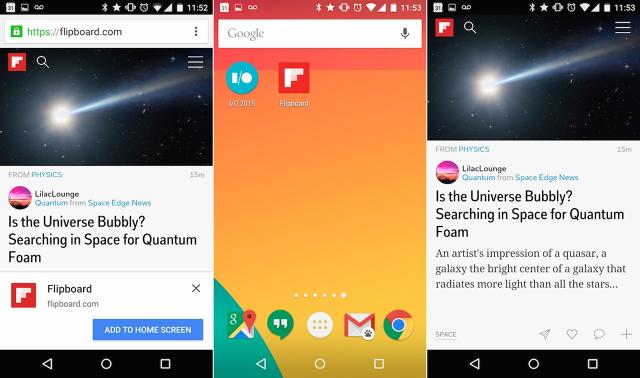How Google And Others Are Plotting The Revenge Of The Web App
For Alex Russell, a developer at Google, making web apps better isn’t just a job: It’s a personal belief.
Since last year, Russell has been championing a new breed of web-based apps that could replace the ones you get from an app store. He calls them “Progressive Web Apps” (his partner, web designer Frances Berriman, brainstormed the name with him) and has been rallying developers to adopt them through talks and blog posts.
Russell is hardly alone in his faith in web apps. For about a decade now, a faction of technologists have argued that the web can provide sufficiently app-like experiences. Steve Jobs originally felt this way about iPhone software, and Google bought into the concept with Chrome OS, a computing platform that was little more than a web browser at its inception. Web apps represent an optimistic view of the world, in which users are free from walled garden app stores, and developers don’t have to rebuild their software for a half-dozen platforms.

In recent years, that optimism has faded, as native apps have handily outperformed web-based ones—both in the marketplace and in terms of the speed they deliver to users. Still, Russell and others believe the web app is ready for resurgence. Developers are getting frustrated with the app store model, and might benefit from the low friction that the open web affords when it comes to getting their wares in front of consumers without middlemen. At the same time, new web technologies allow for apps that are fast and full-featured.
“Building immersive apps using web technology no longer requires giving up the web itself,” Russell wrote last year in a blog post that in retrospect reads like a manifesto. “Progressive Apps are our ticket out of the tab, if only we reach for it.”
What’s In A Web App?
On first visit, Progressive Web Apps are indistinguishable from any other website. You access them through a web browser, and you see all the usual browser clutter—address bar, tab switcher, back button—while using them.
But as the name suggests, these websites can progress into an app-like experience over time. As a first step, they can store some elements locally on the device, using a process called “service workers.” This allows some apps to run without internet access, but more importantly, it cuts down on loading times when the connection is slow, just like native apps do.
“Every time you look at a picture of a kitten, or watch a sloth video on the web, it assumes that the network is there. Native apps don’t do that,” Russell says. “To get something on screen, native apps have a bunch of that [user interface] cached locally, and they only go to the web for fresh data.”

Locally stored data is only the first step in the progression. If the user keeps visiting the same website, it might take another step and ask if you want push notifications. It might also offer an icon for your home screen, just like a native app. Tap on that icon, and the browser chrome might not appear at all. At that point, you’re basically using an app, not a website.
The idea is to make web apps more appealing for the types of tools and experiences that people use constantly rather than just once in a while. “With Progressive Web Apps you’re starting to see us lean toward that heavy usage part of the pie, as well as the ephemeral part of the pie where the web today really shines,” Russell says.
The pursuit of better web apps isn’t just academic. Progressive Web Apps have a real-world advantage, Russell says, in that they don’t have to prove their value to users up front. We’re all used to seeing those obnoxious messages when we visit Yelp or some random news source, urging us to install their native apps instead of loading the mobile website. Most of us ignore these nags, because we don’t want to stop what we’re doing just to download an app we’re not even sure about. Progressive Web Apps at least get a chance to ingratiate themselves first.
“You have a lot less friction,” Russell says. “And I think that’s really the story here.”
Alex Komoroske, the group product manager for Google’s Chrome platform team, gives an example of how a Progressive Web App might work in the real world: Say you’ve just checked into a flight on your phone for an airline that you rarely fly on. You probably don’t want to install their app, but you might still want to get notified of delays or gate changes.
“It’s nice for users to be able to decide precisely how they want to engage with these things, and to do so from a much more informed space because they’re already working with the thing,” Komoroske says.
Why Web Apps Matter
Some tech pundits have argued that it’s too late for the web, citing survey data that shows we spend most of our time (85%, according to Forrester) in just a handful of apps. But those figures are misleading, because they don’t convey how often people visit individual websites, even for short periods, says Jason Grigsby, cofounder of Portland-based web design firm Cloud Four.
“People look at the data around the amount of time people spend in apps versus the web and mistakenly think that means people aren’t visiting mobile websites, or aren’t doing things on mobile web,” Grigsby says. “I hate that statistic . . . it’s just an asinine measure.”
A report last year by ComScore reveals the other side of the story: Collectively, the top 1,000 mobile web properties have an audience that’s 2.5 times larger than the top 1,000 mobile apps. That represents a huge opportunity for Progressive Web Apps.
Except for the highest-profile apps, consumers are increasingly resistant to downloading native software onto their devices, says Max Lynch, cofounder and CEO of Ionic, a company that offers tools for building and scaling mobile apps. “They’re installing these big-ticket apps, and we need reasons for everyone else to be accessible. To me, the answer’s obvious: Google search, SEO, and the mobile web, and then have a native app down the road when someone’s bought into your products.”
Google, for its part, points to case studies where some early Progressive Web Apps have delivered results. Africa-based e-commerce site Jumia, for instance, saw a ninefold increase in conversions by delivering push notifications to web users—a higher rate than its native app. Shopping site AliExpress increased conversion rates by 104% and and time spent by 74% across all browsers. Indonesian news aggregator BaBe saw similar time spent in its Progressive Web App compared to the native version. And at Google’s I/O developer conference in May, visitors spent more time in the Progressive Web App than they did in the native Android app.
“In general, there’s a narrative around the usage of apps that isn’t helpful for businesses making decisions,” Grigsby says. “And I think when you get into savvy businesses, they know that, because they look at their bottom line. They know revenue’s coming from the web, and they can see visitors coming to their website and leaving, and they’re looking for ways to convert those people once they visit their site.”
Dialing Back The Hype (Again)
As promising as Progressive Web Apps sound, the concept is still young, with plenty of unresolved issues.
Some of them are relatively minor, and should improve over time. Progressive Web Apps in the stable version of Chrome can’t yet interact with Bluetooth devices such as fitness trackers or a smart door lock, and Google’s Chrome browser is the only one that supports secure payments through services like Android Pay. And once an web app becomes more immersive, shedding its browser chrome, no one’s settled on the best way to expose URLs, which are what make websites so shareable to begin with.
But Progressive Web Apps also face some knottier existential questions. For instance, they have responsive designs that can scale up to laptops and desktops, but how they should behave on those devices is uncertain. While Microsoft has said it will list Progressive Web Apps in the Windows Store, and run them within Microsoft’s Edge browser, Google’s Komoroske acknowledges that in general there’s a lot left to figure out.

“On desktop, we support Chrome OS, Windows, Linux, Mac, and each of those have different paradigms about where you launch apps, and where you go to manage them, and you have windows and tabs, and it’s a just bigger design challenge to dive into it,” Komoroske says.
Meanwhile, Google itself isn’t betting the farm on Progressive Web Apps as a solution to app store friction. The company has also introduced “app streaming,” which allows Android users to run pieces of an app directly from Google Search. This approach, along with deep linking and new ways to search for content within apps, could erode the web’s inherent advantages.
Russell’s answer to this issue is diplomatic, noting that developers may choose one approach over the other depending on whether they started with an app or a website. “Google doesn’t necessarily have just one opinion about these sorts of approaches, but we’re trying to help developers succeed no matter where they started,” he says.
There’s also the question of whether Apple is on board with the whole Progressive Web App concept. While Apple’s Safari browser supports some of the frameworks, tools, and techniques that make for better web apps in general, it doesn’t enable service workers (for storing website elements locally) or push notifications.
Russell downplays Apple’s limited involvement, noting that designing a modern Progressive Web App will still give iOS users a better experience, even without some of the concept’s more advanced features. But in making this point, he also drudges up deeper question: What if people don’t care about the “progressive” part of Progressive Web Apps?
To Ionic’s Max Lynch, the answer may not really matter.
“To me, the selling point is mobile web, is Google Search,” Lynch says. “When someone searches for a thing on a phone, they get an awesome mobile web experience. To me, that’s the draw, not necessarily the concept that slowly we’ll get more integrated into your life. It’s all about distribution.”
Either way, Russell is happy to tackle these challenges collaboratively with other companies, such as Microsoft, Opera, and Mozilla. The result will be a more advanced version of the web that works everywhere, regardless of browser or operating system.
“It’s not just Google making a thing,” he says. “We’ve tried that in a lot of cases. Sometimes it works, sometimes it doesn’t. But the thing that I’m really excited about here is that it isn’t just us.”
It seems, then, that the decade-old optimism around web apps and open platforms still has a spark left. Why is that?
“I honestly can’t tell you,” Russell says. “I just feel very lucky.”
Fast Company , Read Full Story
(100)


